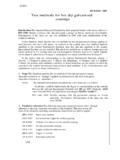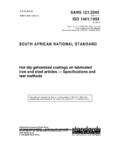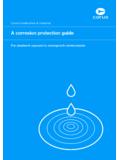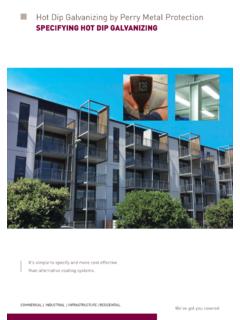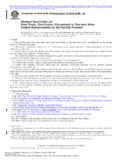Transcription of Study of the Mechanical Properties of N. Coni the Hot Dip ...
1 Study of the Mechanical Properties of the hot dip galvanized Steel and Galvalume J. of the Braz. Soc. of Mech. Sci. & Eng. Copyright 2009 by ABCM October-December 2009, Vol. XXXI, No. 4 / 319 N. Coni M. L. Gipiela A. S. C. M. D Oliveira P. V. P. Marcondes Universidade Federal do Paran UFPR Caixa Postal 19011 81531-990, Curitiba, PR, Brazil Study of the Mechanical Properties of the hot dip galvanized Steel and Galvalume Steel sheet coated with zinc or 55%Al-Zn is widely used at the civil construction, mainly for roofing and cladding applications. The 55%Al-Zn coated steel shows Mechanical Properties slightly different from zinc coated steel, even under the same heat cycle processing, due to the higher molten metal temperature and also to the higher strength of the 55%Al-Zn coating. The knowledge of those differences can be used by the final users to evaluate if some of those products are not suitable for any specific application.
2 Although those two coated products are widely used at the civil construction in Brazil, only a limited literature is available on the difference between the Mechanical Properties of those products. Through tensile tests of commercial grade samples as coated and after removing the coating the aim of this paper is to evaluate the Mechanical Properties (tensile strength, yield strength, total elongation and hardening coefficient) and also how much the coating influences the Mechanical Properties of the zinc and 55%Al-Zn coated steel. The 55%Al-Zn coated steel showed higher yield and tensile strength and lower total elongation and hardening coefficient compared to zinc coated steel and the coating showed a significant influence on the Mechanical Properties of both products. Keywords: galvanized steel, galvalume , Mechanical Properties Introduction1 Due to the many favorable characteristics, steel is well suited and widely used for a broad number of engineering applications.
3 It exhibits a variety of excellent Mechanical Properties , such as strength, toughness and ductility (Akoy et al., 2004). Steel is also easily manufactured and presents good formability, weldability and paintability (Kumar, 2002). Other positive factors include its availability, ferromagnetic Properties , recyclability and low cost. Because steel is susceptible to corrosion in the presence of moisture and to oxidation at elevated temperatures, successful use of these favorable characteristics generally requires some form of protection (Dafydd et al., 2005). Corrosion protection methods employed to protect steel include: altering the metal by alloying, changing the environment by lowering its humidity or by using inhibitors, controlling electrochemical potential by applying cathodic or anodic currents and applying organic and metallic coatings (Parisot et al.)
4 , 2004). Application of metallic coatings by a continuous hot dip process is one of the most widely used means of protecting steel. In this process, the metallic strip is fed through a bath of molten coating metal in a continuous process. Metals and alloys that can be applied as coatings to steel in a continuous hot dip process are limited to those with a melting point low enough to allow steel to be pulled through a coating bath without tearing. These include the coatings: zinc, zinc-iron alloy, aluminium, aluminium-silicon alloy, Zn-5Al alloy and 55%Al-Zn alloy. Metals such as chromium and titanium cannot be applied to steel by hot dipping because of their high melting points (Townsend, 1993). Low-carbon steel sheets coated by hot dipping are available with a broad range of Mechanical Properties . Compared to uncoated steel, they have slightly less ductility because of the thermal effects of the coating process on the precipitation of carbon in the steel associated with age hardening (Safaeirad et al.
5 , 2008). Extra-deep-drawing-quality grades and interstitial-free steel are made with steel that has been vacuum degassed to very low carbon levels and stabilized with additions of titanium and/or niobium (Gupta and Kumar, 2006). The stabilized substrates are 1 Paper accepted May, 2009. Technical Editor: Anselmo E. Diniz relatively immune to the thermal effects of hot dipping and provide excellent formability (Livatyali et al., 2000). Galvalume coated steel sheet with 55 % of Al was developed and has been sold by Bethlehem Steel Corporation since 1972 and, due to its favorable Properties , several of the bigger steel companies around the world are licensed to use the Galvalume production technology. In Brazil, Companhia Sider rgica Nacional CSN is nowadays the only company licensed to produce Galvalume , which has been produced since 2003 at the Continuous Galvanizing Line #5 (CGL#5), located in Arauc ria city State of Paran.
6 Galvalume shows different Mechanical Properties compared to galvanized sheet due to the necessary higher temperature for the 55%Al-Zn alloy molten coating metal (465 C for zinc and 600 C for 55%Al-Zn alloy). Also the 55%Al-Zn coating shows higher strength compared to zinc coating. The aim of this paper is to compare and to evaluate the different results of the Mechanical Properties (tensile strength, yield strength, total elongation and hardening coefficient) of the galvanized sheets and Galvalume coated sheets and also to evaluate how much the coating influences the Mechanical Properties of both coated products. This was done through tensile tests conduced with coated and stripped samples cut from steel sheets produced at CGL#5. Nomenclature t = sheet thickness, mm, and total thickness which means the sum of the base steel and coating thicknesses, mm tb = base steel thickness, mm tc = coating thickness, mm TS = tensile strength, MPa TSs = specific tensile strength, MPa/Mm TSt = tensile strength calculated based on the total or the coated thickness, MPa YS = yield strength, MPa YSb = yield strength calculated based on the base steel thickness, MPa YSt = yield strength calculated based on the total or coated thickness, MPa YSs = specific yield strength, MPa/mm Greek Symbols TS = increasing of the tensile strength, MPa N.
7 Coni et al. 320 / Vol. XXXI, No. 4, October-December 2009 ABCM YS = increasing in the yield strength, MPa = difference of the total elongation between the galvanized and Galvalume sheets as a function of the thickness, dimensionless Zn = total elongation for galvanized sheet, dimensionless GL = total elongation for Galvalume sheet, dimensionless Zinc Coatings Hot-dip-zinc-coated steel sheet, also called galvanized sheet, is by far the most widely used coated sheet product. For general applications, the galvanized sheets have 19 m of zinc thickness per side. This corresponds to a two-side coating mass of 275 g/m2. Heavier coatings are used in applications which require higher corrosion resistance, such as highway drainage culverts. In the automobile industry, where formability and weldability are key considerations, lighter coatings such as 90 g/m2 are more typical (Townsend, 1993).
8 The galling, a form of adhesive wear, affects the cost of forming steel in automotive stamping since it increases die maintenance costs and scrap rates (Kim et al., 2008). Most of the coating is nearly pure zinc. There is an intermetallic layer containing about 6 % Fe, between the substrate and the zinc coating. Aluminium, typically in the range of % to %, is added to the zinc bath in order to prevent the formation of a thick, continuous zinc-iron intermetallic layer that could lead to poor coating adhesion during forming. Aluminium reacts preferentially with the steel to form a thin iron-aluminium intermetallic layer which acts as a barrier and delays the growth of the zinc-iron intermetallic layer. Galvalume is the trade name of steel sheets coated with 55%Al-Zn alloy. It is applied by a continuous hot dip process similar to that of galvanized coatings.
9 This coating combines the durability of aluminium and the galvanic protection of the zinc, resulting in a product which shows excellent corrosion resistance in marine and industrial environments, high temperature oxidation resistance, heat reflectivity of the aluminium coatings and a pleasant and distinctive appearance. The chemical composition of the coating is 55 % of Al, % of Zn and % of Si and it is composed of a three-phase structure as described below (BHP Steel, 1994a): a) a thin quaternary alloy layer, composed of Al, Zn, Fe and Si, between the steel base and the main coating layer; b) an aluminium rich dendritic phase (80 % by volume) and c) a zinc rich interdendritic phase. All the three phases are necessary to provide the improved corrosion resistance Properties . The zinc-rich phase gives the coating its galvanic protection ability, a similar property to a normal galvanized coating.
10 The aluminium rich phase and the alloy layer provide to the coating its durability once the zinc-rich phase is consumed. About % silicon is added to the molten bath in order to control the growth of the alloy layer during the dipping process (BHP Steel, 1994a). As the specific weight of aluminium is lower than that of the zinc, the 55%Al-Zn coating is lighter than the zinc coating, both with same coating thickness. For instance, the weight of the zinc coating designed as G90 (ASTM A653) is 275 g/m2 while the weight of 55%Al-Zn coating designed as AZM150 (ASTM A792) is 150 g/m2. Notice that both coatings have about the same thickness of 20 m per side which results in higher covering area per ton of Galvalume compared to a galvanized product. As an example of the difference, one ton of mm Galvalume can cover % more area than the same thickness of a galvanized sheet (BHP Steel, 1994b).










